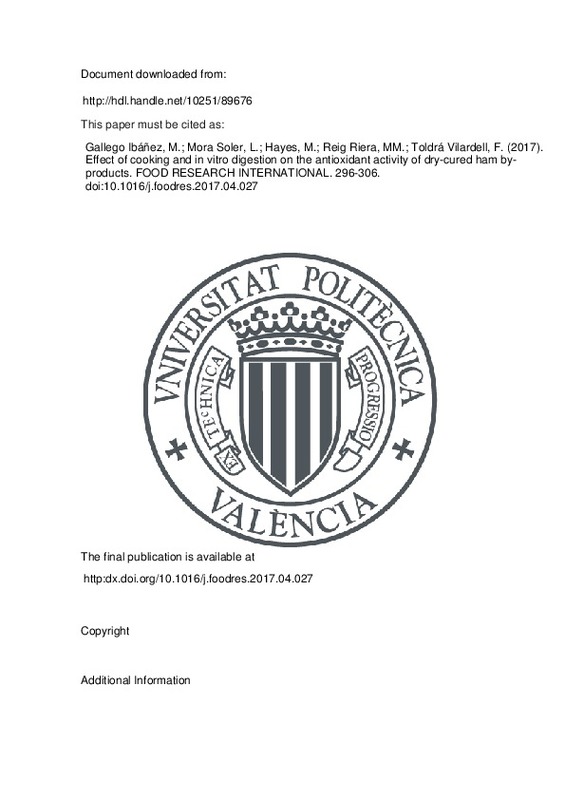JavaScript is disabled for your browser. Some features of this site may not work without it.
Buscar en RiuNet
Listar
Mi cuenta
Estadísticas
Ayuda RiuNet
Admin. UPV
Effect of cooking and in vitro digestion on the antioxidant activity of dry-cured ham by-products
Mostrar el registro sencillo del ítem
Ficheros en el ítem
| dc.contributor.author | Gallego Ibáñez, Marta
|
es_ES |
| dc.contributor.author | Mora Soler, Leticia
|
es_ES |
| dc.contributor.author | Hayes, María
|
es_ES |
| dc.contributor.author | Reig Riera, Mª Milagro
|
es_ES |
| dc.contributor.author | Toldrá Vilardell, Fidel
|
es_ES |
| dc.date.accessioned | 2017-10-20T07:25:27Z | |
| dc.date.available | 2017-10-20T07:25:27Z | |
| dc.date.issued | 2017 | es_ES |
| dc.identifier.issn | 0963-9969 | es_ES |
| dc.identifier.uri | http://hdl.handle.net/10251/89676 | |
| dc.description.abstract | [EN] Dry-cured ham by-products have been traditionally used in Mediterranean household cooking of broths and stews. The aim of this work was to evaluate the effect of cooking treatments and in vitro gastrointestinal digestion on the antioxidant activity of natural peptides found in bones from Spanish dry-cured hams. The antioxidant activity was tested using five different assays and results demonstrated that cooking using conventional household methods increased the antioxidant activity of ham by-products when assessed using different antioxidant assays with the exception of the ABTS radical scavenging measurement assay. Simulated gastrointestinal digestion showed no significant effect on the antioxidant activity of ham by-products and antioxidant activity decreased when assessed using the ORAC and beta-carotene bleaching assays. Analysis by MALDI-TOF MS revealed a considerable breakdown of peptides due to the action of gastrointestinal enzymes, mainly in samples cooked at 100 degrees C for 1 h. In addition, 459 peptides derived from 57 proteins were identified and quantified using mass spectrometry in tandem, evidencing that peptides derived from collagen protein were responsible for the differences in antioxidant activities observed between the uncooked and cooked samples after digestion. The results show the potential of dry-cured ham bones as a source of antioxidant peptides that retain their bioactivity after household cooking preparations and gastrointestinal digestion. | es_ES |
| dc.description.sponsorship | Emerging Research Group Grant from Generalitat Valenciana in Spain (GV/2015/138) and Juan de la Cierva postdoctoral contract to LM are acknowledged. Grant Agreement 614281 (HIGHVALFOOD) and contract to MG are also acknowledged. The proteomic analysis was performed in the proteomics facility of SCSIE University of Valencia that belongs to ProteoRed, PRB2-ISCIII, (IPT13/0001 - ISCIII-SGEFI/FEDER). | en_EN |
| dc.language | Inglés | es_ES |
| dc.relation.ispartof | FOOD RESEARCH INTERNATIONAL | es_ES |
| dc.rights | Reserva de todos los derechos | es_ES |
| dc.subject | Bioactive peptides | es_ES |
| dc.subject | Heat treatment | es_ES |
| dc.subject | Gastrointestinal digestion | es_ES |
| dc.subject | Mass spectrometry | es_ES |
| dc.subject | Ham bones | es_ES |
| dc.subject.classification | TECNOLOGIA DE ALIMENTOS | es_ES |
| dc.title | Effect of cooking and in vitro digestion on the antioxidant activity of dry-cured ham by-products | es_ES |
| dc.type | Artículo | es_ES |
| dc.identifier.doi | 10.1016/j.foodres.2017.04.027 | es_ES |
| dc.relation.projectID | info:eu-repo/grantAgreement/EC/FP7/614281/EU/The Application of Modern Proteomic and Metabolomic Methodologies in the Assessment of High Added-Value Traditional Meat Products/ | |
| dc.relation.projectID | info:eu-repo/grantAgreement/GVA//GV%2F2015%2F138/ | |
| dc.rights.accessRights | Abierto | es_ES |
| dc.date.embargoEndDate | 2018-07-31 | es_ES |
| dc.contributor.affiliation | Universitat Politècnica de València. Departamento de Tecnología de Alimentos - Departament de Tecnologia d'Aliments | es_ES |
| dc.contributor.affiliation | Universitat Politècnica de València. Instituto Universitario de Ingeniería de Alimentos para el Desarrollo - Institut Universitari d'Enginyeria d'Aliments per al Desenvolupament | es_ES |
| dc.description.bibliographicCitation | Gallego Ibáñez, M.; Mora Soler, L.; Hayes, M.; Reig Riera, MM.; Toldrá Vilardell, F. (2017). Effect of cooking and in vitro digestion on the antioxidant activity of dry-cured ham by-products. FOOD RESEARCH INTERNATIONAL. 296-306. https://doi.org/10.1016/j.foodres.2017.04.027 | es_ES |
| dc.description.accrualMethod | S | es_ES |
| dc.relation.publisherversion | http:dx.doi.org/10.1016/j.foodres.2017.04.027 | es_ES |
| dc.description.upvformatpinicio | 296 | es_ES |
| dc.description.upvformatpfin | 306 | es_ES |
| dc.type.version | info:eu-repo/semantics/publishedVersion | es_ES |
| dc.relation.pasarela | S\336470 | es_ES |
| dc.contributor.funder | Generalitat Valenciana |







![[Cerrado]](/themes/UPV/images/candado.png)

